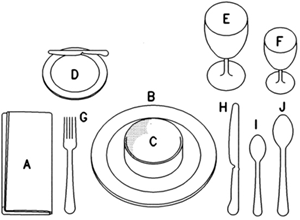Excellent table service is still one of the most crucial
by slave Stewart Siegel
of Fetish Alliance

Family Style
The meal is placed in bowls and platters. The diners serve themselves and then pass the dish to the next person.
Buffet Style
The food is placed on a side board with the plates. The guests serve themselves and take their plate to the table.
Plate
The meal is plated in the kitchen and then served.
Slave
The most time consuming. When seated, warm plates are placed before the guests.
The meal is presented to the guest. This service has limited use today. If you are the only one serving, the number of diners has to be kept small.
Six is the largest that one person can serve and keep the food hot. Many people are not accustomed to serving themselves from a platter and the delay just lets the food get cold.
Service Techniques
The service techniques that you use will depend on the country you are in, the family that you work for and your training. The ones that are generally used in the US are:
-
Serve from the left and remove from the right.
-
Beverages are served from the right.
-
To serve from a platter or bowl use the following techniques:
-
Hold the serving fork and spoon in your right hand. The tines of the fork and the bowl of the spoon should be pointing up. The fork will be on top of the spoon.
The spoon should go between the index finger and the middle finger. The fork will go between the thumb and index finger.
-
Gently scoop the food into the spoon. Push the fork down to hold the food in place. Hold the serving plate over the edge of the diner’s plate and put the food
on the plate. Tip the spoon and fork slightly and release the pressure on the fork.
-
If a left handed person moves their glass to the left of the cover you may pour from the left. Some people may hold the glass up for you to pour: watch out for
this because an accident may occur.
-
Some people may want to drink the same beverage through the entire meal or not at all. Keep an eye on their water glass. European service is different.
-
From the left you present platters, serve from platters, serve salad as a side dish, clean the cover. From the right you set and remove plates, change flatware and pour beverages.

Formal Dining
|
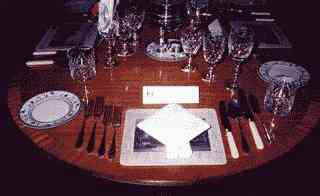
The pride of every Slave, the dinner table.
|
The first thing that you need to discuss with your Master/Mistress is the menu. Have your Party Book handy so you won’t serve the same meal to the same guests twice and
to see who hasn’t been invited to dinner for a while. After the menu is set and the guests chosen, you can decide on the service style and the wine. If the meal is for
more than 12 it should be catered, or use buffet service.
Who is going to serve coffee and after dinner drinks is something to plan now also. Some people have coffee at the table and other serve it in the living room. If its a casual
or small dinner the Master/Mistress of the house may do the serving.
Somewhere in the kitchen have a spare cover set up so you can replace any thing that might get knocked to the floor in the dining room. Have a bottle of club soda and some
towels ready for spills. Another facet of the meal is the number of courses that you are going to have. The classic French meal is 13 courses but today three or four is the
norm. The more courses that you have the smaller the portion of food goes on the plate and less wine in the glass.
The white card above the placemat is a place card, which tells who sits where. Many times the cutlery follows the shape of the table. It might take a slave about 15 minutes
per place setting to create a dinner table that lives up to his standards. So setting a table for 12 persons keeps him busy for hours.
Every place setting should be exactly the same, to the millimeter. An inexperienced slave might use some measuring device.
You might be surprised that there are placemats used and no tablecloth, but this is absolutely correct. Covering up a beautiful antique table for instance would be a shame.
|

NEVER FORGET ...
You are not "just" setting the table ...
You are also setting the mood!
|
|
A. Napkin
B. Service plate
C. Soup bowl
D. Bread and Butter Plate with butter knife
E. Water glass
F. Wine glass
|
G. Wine glass
H. Salad Fork
I. Dinner Fork
J. Dessert Fork
K. Knife
L. Teaspoon
M. Soup Spoon
|
Tablecloth
Pull the chairs away so go can walk around the table freely.
Lay the silence pad down and cover with the tablecloth. Make sure that all the sides are hanging true.
Align the needed chairs so they are spaced evenly down the side of the table. Now sight the chairs that are across the table from each other.
Place Mats
Use last step from above.
Center the place mat on it’s chair.
The edge of the mat should be 1/2 inch from the table’s edge. If you have the large mats the flatware goes on the mat. If you have the small English type the flatware
goes on the table.
Then
-
Pull the chairs away so you can walk around the table freely.
-
Roll the runner down the table and make sure that the ends hang even. The edge of the runner should be 1/2 inch from the table’s edge.
-
Align the chairs so they are spaced evenly down the side of table. Now sight the chairs that are across the table from each other.
-
Place a cover plate in front of a chair. The edge of the plate should be 1 inch from the edge of the table.
-
The basic rules for laying the cutlery are:
-
The handles will be one inch from the edge of the table.
-
The two outer most pieces are used first. (See our illustrations for the correct piece of flatware for a course).
-
A soupspoon may go between knives if there is an appetizer before the soup.
-
The butter knife on the bread plate has the blade face into the center of the plate.
-
Only the soup course has one piece of flatware all others have two. A salad should be torn into bite size pieces but a knife may
be used to push the food onto the fork.
-
If you have individual salt and pepper shakers they go above the main course fork or above the dessert flatware. If people have to share the shakers they go
between the covers.
-
The bread plate can either go to the left of the forks or above the forks to the of the salt and pepper shakers.
-
The wine glass for the main course is above the knife for that course. The water glass goes inside the red wine glass and a little above it. The white wine glass goes on
the outside of the red wine glass and a little closer to the flatware. If there are other wine glasses used they can lined up behind the first two glasses.
-
WHEN NECESSARY (this is restaurant style!): The flatware for dessert goes directly above the plate. The fork goes closest to the plate with the tines pointing to the
right. The spoon goes above the fork with the bowl pointing to the right.
-
The flower arrangements should not be above eye level.
-
Try to set the candelabras so that everybody can make eye contact.
Seating Guests
This is a guessing game at best. You will place people at the table according to social rules. The Master is always at the farthest end of the table, and the person who
is being honored is placed at the other head. If there is nobody being honored, then you will place the highest ranked Master at the other head. This selection should be
made by the Master. The Master’s slave should be seated to the right of the Master (if they are eating at the table). If there is no room for all of the slaves, then they
should be placed at either a separate table to eat (if they are eating at the same time) or if they are not eating, they should be standing behind their Masters (if they
are not serving).
Serve the guest of honor first. If you are the only server finish that side of the table. Then serve the wife/husband/significant other (if not a slave) of the guest honor
and her side of the table.

Luncheon
|
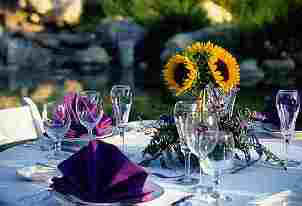
|
|
As breakfast, a lunch is a quiet affair.
|
The cold courses can already be on the table (such as a salad and cheese with crackers). Note that there should be pepper and salt set for every person. The basket
contains the bread
From a setting you can tell that that is all the food that will be served. There is a knife and fork to use with the salad and a knife to use with the cheese.
The water glasses will already be filled, the wine glasses will be filled by the Butler at the start of the meal. After the salad course, he will clear the table and
bring in new plates for the cheese.
A. Napkin
B. Luncheon plate
C. Soup bowl on a liner plate
D. Bread and butter plate with butter knife
E. Water glass
|
F. Wine glass
G. Luncheon fork
H. Knife
I. Teaspoon
J. Soup spoon
|
A Good Master...
Once seated at the table, no one should ever have to ask for a refill. Avoid blinding your guests with candles or obstructing their views of each other with large flower
arrangements or large centerpieces. Never use scented candles... they can have an unappetizing effect. Help guests shine in conversation. Stop a bore from droning on. Steer
away from topics that might cause arguments or offend someone. When serving, place food in distinct areas on each plate. If all the courses won’t fit on a single plate,
make sure you provide an extra small one. Before dessert is served, the table should be completely cleared of all dishes from the previous courses. This includes wine
glasses, salt and pepper shakers, and condiments dishes.

Breakfast
|
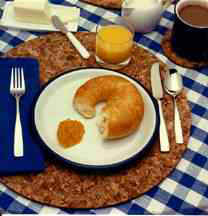
|
|
It is basically a self service affair.
|
The food is usually on a sideboard or a serving table in the dining room. This is a very practical serving formula when there are houseguests, or when not everybody wishes
to eat at the same time.
On the sideboard there can be any choice of food and drink, kept hot as appropriate. There will be cups, plates, extra silver and maybe a toaster and bread, so everybody
can make their own toast.
The slave will serve the coffee or tea and any food that is made to order in the kitchen. He/she might also bring in the mail or a newspaper. During breakfast he will
occasionally come into the dining room with a pot of fresh coffee, to remove used glasses and dishes or to re-set the table for latecomers.
Many people are not at their best early in the morning and the slave should respect this by leaving them alone as much as possible! Also, the picture shows a tablecloth
that is much to short, but we all know that we sometimes have to do with what we have!
A. Napkin
B. Luncheon Plate
C. Cereal Bowl
D. Bread and Butter Plate
E. Cup & Saucer & Teaspoon
|
F. Water Glass
G. Juice Glass
H. Fork
I. Knife
J. Teaspoon
|

Table Linens
Silence Pad
The pad should hang over the edge at least three inches on all sides. This may have to be adjusted to comply with the length of the tablecloth size. You can have one
custom made for the table or you can go to a fabric store a buy some thin felt to do the job. Several may be needed to accommodate the number of leaves in the table.
White should be the only color that you need.
Tablecloth
The cloth should hang down at least five inches all the way around. NO CREASES! Iron out any fold marks before you use the cloth. If the cloth is lace or crocheted you may
have to use either a brown silence pad or hard place mats for the plates. If stemware does not sit flat and solidly you may have to have plexi-glass mats made for them.
Place Mats
There are a couple types of place mats we use. The cloth ones should be ironed very stiff. If you are serving children you may want to stain proof them for the meal.
The rigid type may come in two sizes depending on where they come from and who is using them. The British type for dinner plates may be smaller than the plate. The
flatware will lay on the table. The larger one will be for the serving dishes placed on the table. The American type are larger and will hold both the dinner plate
and the flatware. They should be 1/2 inch from the edge.
Runners
These are rarely used today but may be found some homes. They should be 1/2 inch from the edge of the table. The head and the foot seats should have matching place mats.
Napkins
Only cloth napkins will do for a formal meal. They should be spotless and soft to the touch. The less that they are handled the better so try and keep the folds simple.
Doilies
These have faded from use but have a niche to fill. If you are using cover plates a doily will help cut down on the rattling noise. If you are carrying a bowl on a
plate or serving a sauce from a boat the doily will help hold everything on the plate. A dot of water will hold the doily to the plate.
Coasters
These too have gone from service. It is a nice touch to have a coaster under the water glass. When the wine glass is switched for the next course the succeeding glass
would go on the coaster. If you use these you will have to remove the old wine first and then pour the new wine.
Chart:
Proper tablecloth drop is 6" to 12" per side. Chart is designed to allow for variation in table rise.

Preparations
|
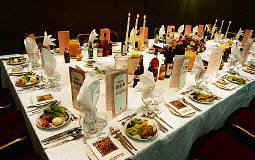
Preparations...
The difference between a highly
successful and an average event.
|
-
Ten minutes before you serve you should light the candles. Do this with a lighter so the room doesn’t smell of sulfur. Get the pets out of the way if required.
-
Put three ice cubes (if used) in the water glasses and fill with water. If you are using bottled water make the ice from the same type of water. Put butter pats on
the bread plates.
-
Tell the Master/Mistress when the meal is ready, and then have the Master/Mistress of the house get everybody to the table. Put an empty garbage can in a convenient
spot in the kitchen, for the scraps.
-
Pour the first wine. You will have discussed what wines that you are going to serve with the Master/Mistress. If you are serving a three course meal there may be only
one or two wines. If there are five or six courses there may be six or seven wines. The more courses that you have the less wine you pour in the glass. Never mix wines
in the glass. Let the person finish the glass they have and then pour from a new bottle.
-
While they are eating you should get the next course ready. If there is call buzzer in the dining room have the Master/Mistress of the house ring it once when the course
is almost over and twice for the next course. If there is no buzzer carry the water pitcher and the wine around the table to see how fast they are eating and who needs a
refill. Start plating the next course. Potatoes and rice hold their temperature very well. A meat with sauce does also. Vegetables without sauce go cold very fast. You’ll
have to do this part by instinct. Put the hot plates on a bath towel, they will stay warmer longer.
-
Remove the cover and salad plates.
-
Plate the next course and serve. Pour the next wine and remove the old wine glass. Check water and butter. Put the flatware in a plastic container filled with warm water,
soap and silver polish. Scrap the waste into the empty garbage, do not to run the disposal while the guests are in the house. Rinse the dishes. Put the glassware out of
harm’s way.
-
Repeat as necessary.
-
During the main course duck into the living room and remove the glasses and wipe the ashtrays out. Fluff the cushions. The room should look like there has been no one
there. Set out the after dinner drinks and glasses. Light/Stoke fire as needed.
-
When serving dessert the only things that are on the table are the flatware for the course, the wine glass for the course, water glass, candles and the flowers.
Everything else is removed. If there are crumbs from the bread wipe these off with a folded napkin onto a small plate.
-
Present the dessert if required. Show it at every corner. Have two of what you are serving with a slice cut from one to show the inside if possible. If it’s a
slice of something the point goes toward the diner. If its in a bowl, the bowl goes on a plate with a doily.
-
If coffee is served at the table put the cups where the knives use to be. The handle will be to toward the right. Make both regular and decaffeinated. Try to
have a selection of sweeteners and creamers on a small silver tray that you may pass. Have a boiling pot of water and a tea bag at the ready.
-
After the meal is over and they have left the dining room extinguish the candles. Have a small bowl of ice water ready. Put you thumb and forefinger in the cold
water and then pinch the wick near the top. The trick is keep the wick from smoking. Dip your fingers in the water between each candle or push the wick into the
molten wax.
-
Back in the kitchen it is time to start washing the dishes. Fill the pots and pans with water. Put them on the stove and put a tablespoon of dishwasher powder and they
wash them selves. If they start to boil turn off the heat. Fill any roasting pans with hot water and soap and let soak. Cover the flat areas of the kitchen with towels
and set the dish racks out.
-
Make sure that you have plenty of drying towels on hand. A couple of dozen will do. Wash the dishes first. Let them air dry in the racks. If you have dishwasher safe
rinse the plates well and load the washer. Don’t run it until the guests have left.
-
Change the wash and rinse water. I usually have a plastic cup filled with warm water and some liquid soap. This cuts down on the time for filling the sink and I have more
hot water to rinse with. The glasses are next. Pour the excess wine down the drain and wash inside the bowl. Watch out for lipstick on the rims. If the rims are very thin
you may want to use you finger tips to remove any muck form the sides of the bowl. Rinse well and place bowl side up out of the way and let the water drip off.
-
The flatware should have soaked enough now and can be washed. Never use a scouring pad on flatware. Wash each piece and place it in some fresh hot water. Rinse it
off again and lay it on the towels. Separate and count it to make sure that all the pieces are there.
-
The plates should be dry and can be put away. Dry the flatware next and return to it’s chest
or drawers.
-
Tidy the kitchen. Remove the wet towels. Put the dish racks away. Move the garbage can out of the way. Open the window and get some fresh air. If possible change uniforms.
This will get you out of the kitchen, let you stretch and use the restroom.
-
The glasses are last. Have plenty of towels ready. Drape a towel over one of your hands, palm up. The longer side will hang over your little finger. Tip out the
excess water. Grab the stem of the glass with the towel The towel is now hanging down from the bottom of the bowl and over the base. Gather the bottom of the towel
and gently insert it into the glass. Your thumb and little finger will be outside the glass and the other fingers inside. Hold the glass horizontally. Dry the stem
and base of the glass. Rotate the glass and dry the bowl.
-
The rest of the evening you will have to play by ear. If the guests leave one by one be at the door to help them with their coats. Usually when this happens the
lady of the house will let you go for the night. After all the guests have left you tidy up the living room again and at least rinse out the cups and glasses before
going to bed. If they all leave at once, try and get everything washed that night. Take out the trash. Soak the linens overnight in the washer. I try to get all the
washing up done that night unless it gets to be to late (after 2 A.M.). Get everything out of the public rooms and into the kitchen. Don’t neglect your morning duties
but try to get as much cleaning done as possible.

Afternoon Tea
High Tea
Smoke
|

|
|
Serving at Afternoon Tea,
High Tea or a Smoke
|
When serving, the food is prepared in a buffet style, and is usually finger sandwiches. The food is placed on doilies on a platter that is walked around or placed on a
table. The food should not be messy, and need a plate. A napkin is always served with the food.
Beverages should be light (but the choices are usually up to the master). If wine, beer, or liquor is served, it should be poured on an as needed basis. The beverages
should be received from a hidden or side bar, and should be served by the slave. The glass should be held from the bottom, so the Master/Mistress would be able to pick
it up by the bowl, or by the stem. If coffee or tea is served, it should be on a saucer, and should only be handled by the saucer. If the people are standing (and not
at a formal table), the slave should request what is wanted in the beverage (i.e. if coffee or tea, milk, sugar, sweetener, lemon, etc.).
A High Tea, is usually at 4:00PM (but it is more of a format these days than a time). High Tea is for the women, and a Smoke is for the men (but either can be at both
these days). High Tea always has cloth napkins, served on a tray with a napkin on the bottom of the tray, and always contains finger sandwiches.
A Smoke comes from the men of Victorian Times when they went into the library to have their cigars. Cigars are served as follows:
-
Always have a selection of cigars
-
Should be served on a tray (usually silver)
-
Never precut a cigar
-
Cut the cigar no more that 1/8 up from the stubbed end
-
Light the cigar with either a refillable butane lighter, or a flint lighter that uses a fluid, such as a Zippo lighter. Never light with a match, unless you are using
wooden matches.

Serving Tips
The following is excerpted from the book;
A Butler’s Life:
Scenes From the Other Side of the Silver Salver
by Christopher Allen and Kimberly Burton Allen.
14 Tips For Averting Entertaining Emergencies:
-
Never serve just one dish, especially when it’s something exotic - for example, seafood gumbo - without enough other side dishes to cover. Otherwise, if a guest
is allergic to or dislikes a key ingredient in your dinner - shellfish - you will have no backup.
-
Whatever the main course, serve lots of different vegetables
— three or four varieties. Not only do vegetables add necessary color, but if you get an unexpected extra guest, you can reduce the size of entrée and still fill the plate.
-
Many vegetables can be prepped in advance of use. The day you buy cauliflower, broccoli, carrots, green beans and other "hard" vegetables, wash, pare
and cut them into bite-sized pieces. Then cover them with a little water in airtight containers, and refrigerate for up to a week. Fresh vegetables will always
be available, regardless of how last-minute the meal may be.
-
For impromptu barbecues, chicken thighs and drumsticks can be defrosted very quickly. Also, hamburger meat can be made into patties and frozen. Separate these with
wax paper and wrap in freezer paper, not foil — the latter has a tendency to stick when you’re in a hurry.
-
A supply of ice cream, topped with frozen berries quickly thawed in the microwave, will always yield an easy, pretty dessert. Also, don’t overlook your liquor cabinet.
Liqueurs such as Kahlúa, Creme de Cassis, Creme de Menthe, Grand Marnier, Amaretto, Frangelica, or any cream liqueur such as Bailey’s Irish Cream make elegant toppings
for ice cream. Serving ice cream in footed glass bowls or large wine glasses with a single mint sprig adds extra flourish.
-
A dish containing avocados is never a good choice for last-minute entertaining (unless they’re in season and you have a tree in your garden!). Avocados are ripe when
they’re just soft, and for general recipe use should be purchased at least a week in advance.
-
Make and freeze homemade soups, particularly when seasonal vegetables are most abundant. Heated and served with hot rolls or a loaf of fresh bread, it is one of the
coziest meals possible on short notice.
-
If you boil a chicken, reduce the liquid and freeze it. Chicken stock is the best base for soups, and homemade is still far superior to canned.
-
Your freezer should always have frozen peas and corn. They are quick to cook and are great for adding color to any dish.
-
Have at least four types of pasta on hand in the pantry. Most cook in less than fifteen minutes. The addition of sautéed fresh vegetables, some cream and Parmesan
cheese results in Pasta Primavera, an excellent vegetarian alternative to omelets.
-
Frozen shrimp (30-40 count) and scallops, often available in 1-1/2 pound bags in discount food warehouses, are invaluable. They can be defrosted in minutes and
added to pasta, sautéed with garlic, butter and wine and served with rice, or boiled briefly and served on ice with cocktail sauce - a perennially popular hors
d’oeuvre.
-
For picture-perfect vegetables, even when the meal is delayed, parboil the vegetables until just tender, then plunge them immediately into ice and cold running water.
(This arrests the cooking process and also fixes the color.) After a few minutes in the cold bath, drain the vegetables and set aside. A few minutes prior to serving,
finish cooking them by dropping them back into hot water, or by quickly sautéing them in butter for a couple of minutes. (Carrots finished this way are glistening.)
-
Try to prepare as much of a meal as possible in advance. If it is ready to go, you can delay or move a meal up if necessary. Choose recipes that can be made in
advance, and simply finished off at the last minute. Pre-prepare salads, pâtés, soups. Even soufflés can be prepared to the stage of needing only the addition
of the whipped egg whites.
-
Buy food in season, in good supply. Never buy cheap provisions; quality will always win out. (I made the mistake of buying frozen fruit cocktail in bulk once.
It was limp, tasteless, and without color, and no one finished it.)
|





